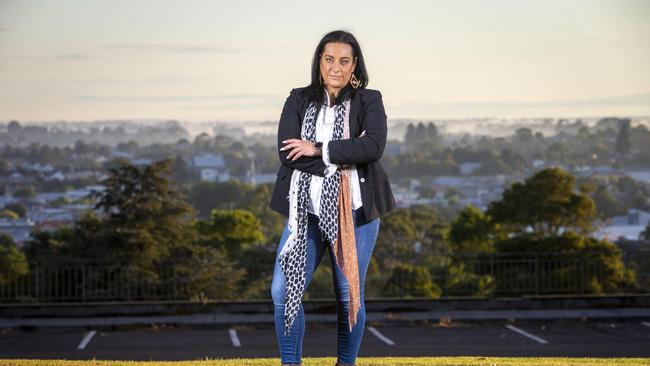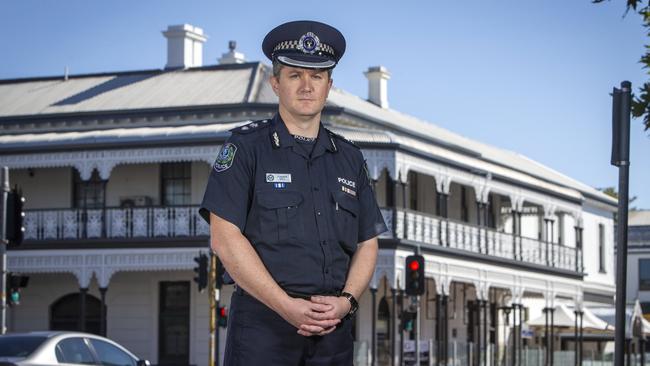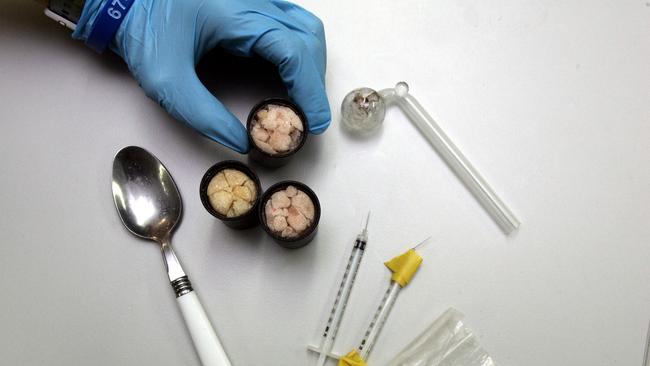Hard road: How ice addiction puts users on a collision course with police
Drug drivers killed 20 and injured 60 last year but tougher penalties are unlikely to deter some who “just don’t care”. But there’s one thing we should try more.
Police & Courts
Don't miss out on the headlines from Police & Courts. Followed categories will be added to My News.
Drug drivers claimed the lives of 20 people on the state’s roads last year and injured another 61 people – the highest number of serious injuries in more than five years.
The state’s top traffic cop labelled drug drivers “irresponsible and selfish”, while victims’ advocates say drug drivers “vastly underestimate” the risks of drug driving.
It comes as an analysis by The Advertiser shows the penalties for drug driving in South Australia are among the lowest in the nation.
Fines for a first offence in SA range from $1100 to $1600, compared with $2180 in Victoria and $3300 in NSW, leading to calls for tougher penalties to be imposed to deter motorists.
Traffic Services Branch officer in charge, Superintendent Bob Gray said drug driving was a “significant issue” for police and caused crashes that “never needed to occur”.
“There is a sense of frustration because people don’t need to die on our roads and they don’t need to be seriously injured by (someone) taking drugs and then having a bad outcome,” he said.
“It is one of the most emerging factors in lives lost and serious injury crashes.”
Last year, 20 people lost their lives at the hands of drug drivers – the highest number of deaths since 2017. Superintendent Gray said about one in seven drivers tested for drugs returned a positive result, compared with one in 10 drivers in 2017, with methamphetamine the “most prolific” drug.
Superintendent Gray said tougher drug driving penalties would deter some drug drivers, and significant fines would deter others, but there were others “who really wouldn’t care what the penalties were, they behave like that in any event”.
SA Network of Drug and Alcohol Services executive director Michael White agreed pushing up penalties would lead to changing behaviour among some drivers but said other methods, such as counselling, would benefit about 80 per cent of first-time offenders.
“The courts are absolutely swamped with minor drug cases,” he said. “Early intervention, diversion and a health-led response are critical.”
Police say drugs can be detected in a user’s system for up to 24 hours but Mr White suggests it could be longer and more accurate testing is necessary.
Commissioner for Victims’ Rights Bronwyn Killmier said victims wanted effective penalties that deterred people from drug driving and reflected the magnitude of harm caused.
“(Drug-affected) drivers seem to have little regard for the magnitude of trauma caused by road crashes, trauma that impacts on individuals, families and whole communities,” Ms Killmier said.
Consulting victimologist and former Commissioner for Victims’ Rights Michael O’Connell said it was “obvious” the penalties were not a deterrent.
“The sanctions for drug driving must also have relevance for the victims of road trauma,” he said. “They endure a pain and anguish and consequences of the drug driver’s decision to consume a drug and then drive.
Tip of the ice bergs: Meth ‘capital’ just one of SA’s problem towns
- Michael McGuire
It was the two weeks locked up in the Mount Gambier men’s prison that was the final terrible push that persuaded Jane that she needed to try to change her life.
Since her late teens, Jane, not her real name, had been addicted to ice. It started off an occasional weekend indulgence, a social thing, and grew to three or four times a week. Then it was everything.
“My whole life revolved around it,’’ she says. “Where other people invite friends around for a coffee, we would be invited for a pipe.’’
The addiction cost her everything. Friends, jobs and, worst of all, her daughter, who was taken away from her. Twice, Jane has been convicted of drug driving.
One, she admits, was stupid and reckless. The second time, she had been kicked out of home by her violent partner, needed to flee and had no other choice. It wasn’t the drug driving that sent her to jail though. It was missing a court date. She was arrested and put in prison.
For two weeks, she was left in a cell – no exercise, no fresh air, no chats with other prisoners. It was a men’s prison and for her own safety she was permanently confined.
When we speak, Jane has been clean for six months. This is not her first attempt, but it’s the most determined she’s been. It’s been far from easy. And there is no doubt the road ahead is very hard. She recently had to quit her job because of bullying from workers who were calling her a “crackhead’’ and a “drug addict’’.
Jane’s 31. She’s still fragile, but comes across as a bright, friendly person. There’s a self-deprecating humour there. A sadness as well.
What’s driving her is a desire to be reunited with her four-year-old daughter.
“I just want to be there for my daughter. I want my daughter to have a happy life. I want to show my daughter that none of that life is OK.’’

Mount Gambier knows it has a reputation. When asking people to speak about drugs in SA’s second-biggest city, the response is generally, “oh, you are not going to paint us as the ice capital of Australia again, are you?’’. A TV current affairs show made the claim almost a decade ago and Mount Gambier was the first stop on the federal government’s national ice task force in 2015.
No one denies there is a problem with ice and other drugs, including alcohol, in Mount Gambier, but the city is not alone in that battle. Adelaide is far from immune, while the drug has ravaged many other regional centres.
But new figures provided to The Advertiser by South Australian police show that in the past five years, there have been 1284 drug-driving detections in Mount Gambier. This is far more than anywhere else in SA. Over the same time, there were 792 detections in Murray Bridge, 720 in Port Augusta and 664 in Port Lincoln.
Any visitor to Mount Gambier sees a well-maintained, comfortable regional town. The main street is busy. Trendy-looking coffee shops are full. Tourists flock to see the remarkable lakes. It feels like a prosperous town.
But addiction is often hidden. Occasionally, it forces its way into view, such as the day when a drug-affected John Trevor Taleporos smashed his car through a red light at the city’s main intersection while trying to evade police. Through good fortune, no one died.
Business owners complain of theft and meetings are held looking for solutions.
For all that, the officer in charge of the Mount Gambier police station, Superintendent Campbell Hill, maintains there is no drug-fuelled “crime wave’’ in the city.
As for the numbers of its residents caught driving with drugs in their system, Supt Hill says there are a number of reasons why the numbers are so high.
Partly, it’s simple maths. Mount Gambier has more people than other regional centres. Supt Hill also says police are aware of who the drug users are in Mount Gambier and he makes no apology for targeting them.
“I think when we go looking for things, inevitably we’re going to find it. One of the positives I take from that is that we are targeting the right people,’’ he says.
Supt Hill says the driving force is “our commitment to try and stop these people crashing and killing or injuring people further up the road’’.

Supt Hill says there are other factors which may explain the Mount Gambier numbers. One is that the population swells daily beyond its official 27,000 by as much as another 10,000 as people from surrounding areas, including western Victoria, come into the city. It’s also a tourist town and is a stop on the road from Melbourne to Adelaide.
Then there was Covid. Supt Hill estimates there were twice as many officers in the region carrying out border control duties and naturally more cops leads to more arrests. “There were opportunities, where there was either a manner of driving that necessitated a traffic stop that led inevitably to a drug or alcohol test.’’
Troy Bell is the MP for Mount Gambier and says the numbers of drug-driving convictions is “obviously concerning’’. Part of it, he believes, can be explained by a lack of services in the city. On a Friday or Saturday night, the town’s meagre public transport service stops. He says he often picks up his 18-year-old daughter in the early hours because it takes so long to find a taxi.
“The number of times I’m running one, two or three in the morning for my daughter to come and pick her up, because she’s been waiting for an hour and a half and I don’t want her walking,’’ he says.
But Mr Bell says there are other service problems. He says over the last 20 years, there has been a reduction in drug and alcohol services in Mount Gambier. He says in 2000, there was as many as four drug counsellors in the city. Now there is one.
There’s a need for more detox beds, more education at school and more rehabilitation support for those who want to change their lives. A large part of the problem, Bell says, is that those who hold the purse strings are 500km away and don’t think much beyond Adelaide.
“I do think it’s out of sight out of mind,’’ he says.
Another battling for better services is Kate Amoroso. She is something of a force of nature. A city councillor and an ex-addict who is using her own experiences to help others escape from “the life’’.
Ms Amoroso’s story is confronting. Her descent into full-blown addiction started when she injured her back and was put on morphine to kill the pain. This would lead to depression, anxiety and weight gain. She started having suicidal thoughts and was prescribed a variety of antidepressants, as well as the pain killers. She was placed in psychiatric units but when released there was little support. Ms Amoroso says she’s not making excuses for her behaviour “because it’s still our choice’’, but thinking straight when your mind and body is full of chemicals is difficult. And then came the illegal drugs. The rational was straightforward.

“I want to die, lost everything, lost my property, lost my house, lost my job. I can’t see why this is going to be any worse than the position I’m already in,’’ is her memory.
And the ice, temporarily at least, gave “a break from the madness in your head’’. Her life spiralled out of control but Ms Amoroso says she “never realised that I needed to get out of it until the last time’’.
“People in active addiction don’t realise that they’re in active addiction,’’ she says. That last time, though, is a horror story. It was a bender that lasted days. She says it’s a “bit of a blur’’ but would later find she had five illicit drugs in her system, although she is adamant she didn’t voluntarily take that many.
Eventually, she barricaded herself in her house, police were called and streets shut down. Finally, she was taken away in an ambulance and flitted in and out of consciousness for weeks. When she woke, she didn’t know who she was, couldn’t recognise her family and didn’t know how to walk or talk.
It was a long road back. The “hard yards’’, Ms Amoroso calls it, but she has been free of legal and illegal drugs for eight years and all her energies are now directed towards helping others escape their drug problems. She says it’s her way of giving back after “the amount I took out of the community’’.
“I could never ever say enough sorries to replace the trauma that I’ve caused on some people, it’s awful.’’
Ms Amoroso is campaigning for more services in Mount Gambier. More mental health and detox facilities and rehabilitation services. She says it’s about “wraparound services’’ that will support addicts. She believes in mandatory rehabilitation for high-end repeat offenders. And says the pandemic and its forced isolation for many will make things worse.
“Mental health is an illness, addiction is an illness and 90 per cent of the time they go hand-in-hand. It’s a health problem,’’ she says.
Substance Misuse Limestone Coast published a survey of regional service providers in November, looking at the impact of Covid on drug use and service providers. The survey found the government sector saw large increases in behaviour prompted by what they termed “alcohol and other drugs’’. It found increases of up to 25 per cent in suicidal and mental health presentations, cannabis, opiate, methamphetamine and GHB use. There was a similar rise in incidents of domestic violence.
Jane says most addicts wouldn’t have a clue how to extract themselves from drugs, even if they wanted to. She is being helped by Ms Amoroso. But she talks of some of the practical obstacles put in place by the system, such as being forced to travel to Adelaide to reclaim a drivers’ licence. When money is tight, that is a big financial imposition and Jane only managed it after help from a charity.
“We need to find a way to help people rather than punish people,’’ she says. “Some believe they have no other option than drugs.’’




